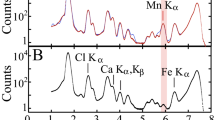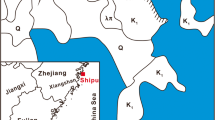Abstract
Biomineralization is the process by which living organisms or organic matrices produced by them initiate and structure deposition of inorganic polymers/minerals. Deep-sea polymetallic nodules and crusts have recently been recognized as biominerals that are formed around bio-seeds; these deposits are of economic value. A detailed understanding of their formation will contribute to their sustainable exploitation in the future. Polymetallic nodules grow concentrically around discrete nuclei that have recently been described as bio-seeds formed from microorganisms, diatoms, or coccoliths. In the present study, polymetallic nodules from the Clarion-Clipperton Zone have been analyzed. It is described that the approximately 5-cm large polymetallic nodules are composed of micronodules (size of 100–450 μm) that aggregated to nests (2–3 mm). High-resolution scanning electron microscopy (HR-SEM) and high-resolution energy dispersive X-ray (HR-EDX) spectroscopic analyses revealed that the micronodules are composed of discrete layers of Mn and Fe. Imprints of microorganisms/microbe-like assemblies are found in the Mn-rich regions of the micronodules. HR-SEM/EDX analyses confirmed that these microorganisms are surrounded by a Mn-rich environment. These findings strongly suggest that those organisms acted as bio-seeds that allowed the deposition of Mn(IV) minerals which in turn helped Fe minerals to associate. Hence, these data support the concept that the growth of the polymetallic nodules starts as a biomineral and is completed by genuine mineralic depositions. It is expected that these data will contribute to the development of strategies for a sustainable exploitation of the polymetallic nodules.








Similar content being viewed by others
References
Arc M (2010) Seamount mineral deposits. Oceanography 23:184–189
Arcuri EJ, Ehrlich HL (1979) Cytochrome involvement in Mn(II) oxidation by two marine bacteria. Appl Envir Microbiol 37:916–923
Aschner M, Guilarte TR, Schneider JS, Zheng W (2007) Manganese: recent advances in understanding its transport and neurotoxicity. Toxicol Appl Pharmacol 221:131–147
Banerjee R, Roy S, Dasgupta S, Mukhopadhyay S, Miura H (1999) Petrogenesis of ferromanganese nodules from east of the Chagos Archipelago, Central Indian Basin, Indian Ocean. Mar Geol 157:145–158
Baturin GN (1982) Phosphorites on the sea floor: origin, composition and distribution (Developments in Sedimentology). Elsevier, Amsterdam, pp 1–343
Bau M, Koschinsky A, Dulski P, Hein JR (1996) Comparison of the partitioning behaviours of yttrium, rare earth elements, and titanium between hydrogenetic marine ferromanganese crusts and seawater. Geochim Cosmochimi Acta 60:1709–1725
Blueford JR, Murchey B (1993) Radiolaria of giant and subgiant fields in Asia. Micropaleontol Spec Publ 6:1–299
Brown BE, Tudhope AW, Le Tissier MDA, Scoffin TP (1991) A novel mechanism for iron incorporation into coral skeletons. Coral Reefs 10:211–215
Burnett BR, Nealson KH (1981) Organic films and microorganisms associated with manganese nodules. Deep Sea Res 28A:637–645
Cha JN, Shimizu K, Zhou Y, Christianssen SC, Chmelka BF, Stucky GD, Morse DE (1999) Silicatein filaments and subunits from a marine sponge direct the polymerization of silica and silicones in vitro. Proc Natl Acad Sci USA 96:361–365
Decker R, Schlickum U, Klappenberger F, Zoppellaro G, Klyatskaya S, Ruben M, Barth JV, Brune H (2008) Using metal-organic templates to steer the growth of Fe and Co nanoclusters. Appl Phys Letts 93:243102–243104
Dick GJ, Lee YE, Tebo BM (2006) Manganese(II)-oxidizing Bacillus spores in Guaymas Basin hydrothermal sediments and lumes. Appl Environ Microbiol 72:3184–3190
Douville E, Bienvenu P, Charlou JL, Donval JP, Fouquet Y, Appriou P, Toshitaka G (1999) Yttrium and rare earth elements in fluids from various deep-sea hydrothermal systems. Geochim Cosmochim Acta 63:627–643
Dymond J, Lyle M, Finney B, Piper DZ, Murphy K, Conard R, Pisias N (1984) Ferromanganese nodules from MANOP Sites H, S, and R—control of mineralogical and chemical composition by multiple accretionary processes. Geochim Cosmochim Acta 48:931–949
Edwards KJ, Bach W, McCollom TM (2005) Geomicrobiology in oceanography: microbe–mineral interactions at and below the seafloor. Trends Microbiol 13:494–456
Ehrlich HL (2001) Ocean manganese nodules: biogenesis and bioleaching. In: Kawatra SK, Natarajan KA (eds) Mineral biotechnology: microbial aspects of mineral beneficiation, metal extraction, and environmental control. American Technical Publishers Ltd, Littleton, pp 239–252
Ehrlich HL (2002) Geomicrobiology. Marcel Dekker, New York
García CG, de la Puente LS (1977) The absorption of manganese (III) in oat plants. Plant Soil 47:229–237
Gilbert PUPA, Albrecht M, Frazer BH (2005) The organic–mineral interface in biominerals. Rev Mineral Geochem 59:157–185
Glasby GP (1972) The mineralogy of manganese nodules from a range of marine environments. Mar Geol 13:57–72
Glasby GP (2006) Manganese: predominant role of nodules and crusts. In: Schulz HD, Zabel M (eds) Marine geochemistry, 2nd edn. Springer, Berlin
Glasby GP, Meylan MA, Margolis SV, Backer H (1980) Manganese deposits of the Southwestern Pacific Basin. In: Varentsov IM, Grasselly G (eds) Geology and geochemistry of manganese, vol 3. Hungarian Academy of Science, Budapest, pp 137–183
Goldberg VM, Obukhova LK (1967) Kinetics of the reduction of trivalent manganese by caproic acid. Russ Chem Bull 16:1376–1380
Halbach P (1986) Processes controlling the heavy metal distribution in Pacific ferromanganese nodules and crusts. Geol Rund 75:235–247
Halbach P, Friedrich G, von Stackelberg U (1988) The manganese nodule belt of the Pacific Ocean. Enke, Stuttgart
Han X, Jin X, Yang S, Fietzke J, Eisenhauer A (2003) Rhythmic growth of Pacific ferromanganese nodules and their Milankovitch climatic origin. Earth Planet Sci Lett 211:143–157
Hansel CM, Francis CA (2006) Coupled photochemical and enzymatic Mn(II) oxidation pathways of a planktonic Roseobacter-like bacterium. Appl Environ Microbiol 72:3543–3549
Heath GR (1981) Ferromanganese nodules of the deep sea. Econ Geol 75:736–776
Jochum KP, Stoll B, Friedrich JM, Amini M, Becker S, Dücking M, Ebel DS, Enzweiler J, Hu M, Kuzmin D, Mertz-Kraus R, Müller WEG, Regnery J, Sobolev A, Wang X, Zhan X (2009) Laser ablation-ICPMS and its application in geochemistry, cosmochemistry and environmental research. Rock Miner Anal 28:53–68
Konhauser KO (1998) Diversity of bacterial iron mineralization. Earth Sci Rev 43:91–121
Koschinsky A, Halbach P (1995) Sequential leaching of marine ferromanganese precipitates: genetic implications. Geochim Cosmochim Acta 59:5113–5132
LaRock PA, Ehrlich HL (1975) Observations of bacterial microcolonies on the surface of ferromanganese nodules from Blake plateau by scanning electron microscopy. Microbiol Ecol 2:84–96
Lenoble JP (2000) Polymetallic nodules. International Seabed Authority, Kingston (1/10/00)
Lowenstam HA, Weiner S (1989) On biomineralization. Oxford University Press, Oxford
Marcus MA, Manceau A, Kersten M (2004) Mn, Fe, Zn and As speciation in a fast-growing ferromanganese marine nodule. Geochim Cosmochim Acta 68:3125–3136
Martin W, Baross J, Kelley D, Russell MJ (2008) Hydrothermal vents and the origin of life. Nat Rev Microbiol 6:805–814
Müller WEG, Belikov SI, Tremel W, Perry CC, Gieskes WWC, Boreiko A, Schröder HC (2006) Siliceous spicules in marine demosponges (example Suberites domuncula). Micron 37:107–120
Müller WEG, Wang XH, Belikov SI, Tremel W, Schloßmacher U, Natoli A, Brandt D, Boreiko A, Tahir MN, Müller IM, Schröder HC (2007) Formation of siliceous spicules in demosponges: example Suberites domuncula. In: Bäuerlein E (ed) Handbook of biomineralization, vol 1, Biological aspects and structure formation. Wiley, Weinheim, pp 59–82
Müller WEG, Schloßmacher U, Wang X, Boreiko A, Brandt D, Stephan EW, Tremel W, Schröder HC (2008) Poly(silicate)-metabolizing silicatein in siliceous spicules and silicasomes of demosponges comprises dual enzymatic activities (silica-polymerase and silica-esterase). FEBS J 275:362–370
Rawlings DE, Kusano T (1994) Molecular genetics of Thiobacillus ferrooxidans. Microbiol Rev 58:39–55
Schröder HC, Wang XH, Tremel W, Ushijima H, Müller WEG (2008) Biofabrication of biosilica-glass by living organisms. Nat Prod Rep 25:455–474
Schütt C, Ottow JCG (1980) Reductive microbial dissolution of manganese nodules as a possible hazard of deep-sea mining. Helgolaender Meeresun 33:443–451
Somayajulu BLK (2000) Growth rates of oceanic manganese nodules: implications to their genesis, palaeo-earth environment and resource potential. Curr Sci 78:300–308
Stein LY, Jones G, Alexander B, Elmund K, Wright-Jones C, Nealson KH (2002) Intriguing microbial diversity associated with metal-rich particles from a freshwater reservoir. FEMS Microbiol Ecol 42:431–440
Stoffers P, Glasby GP, Frenzel G (1984) Comparison of the characteristics of manganese micronodules from the equatorial and South-West Pacific. Tschermaks Mineralog Petrogr Mitt 33:1–23
Tebo BM, Johnson HA, McCarthy JK, Templeton AS (2005) Geomicrobiology of manganese(II) oxidation. Trends Microbiol 13:421–428
Thiel GA (1925) Manganese precipitated by microorganisms. Econ Geol 20:301–310
Thijssen T, Glasby GP, Friedrich G, Stoffers P, Sioulas A (1985) Manganese nodules in the Central Peru Basin. Chem Erde 44:1–12
Towe KM, Cifelli R (1967) Wall ultrastructure in the calcareous foraminifera: crystallographic aspects and a model for calcification. J Paleontol 41:742–762
Van Veen WL (1973) Biological oxidation of manganese in soils. Antonie Leeuwenhoek 39:657–662
Wang Y, Gao Y (1994) Practical x-ray spectral line charts and tables. Geological Publishing House, Beijing
Wang XH, Müller WEG (2009) Marine biominerals: perspectives and challenges for polymetallic nodules and crusts. Trends Biotechnol 27:375–383
Wang XH, Bu SB, Gao XH, Hao GZ, Zhang SY, Wang YM (2000) Rapid analysis of mulit-elements in polymetallic nodule by XRF. Jf Instr Anal 19:1–4 (in Chinese)
Wang XH, Boreiko A, Schloßmacher U, Brandt D, Schröder HC, Li J, Kaandorp JA, Götz H, Duschner H, Müller WEG (2008) Axial growth of hexactinellid spicules: formation of cone-like structural units in the giant basal spicules of the hexactinellid Monorhaphis. J Struc Biol 164:270–280
Wang XH, Schloßmacher U, Wiens M, Schröder HC, Müller WEG (2009a) Biogenic origin of polymetallic nodules from the Clarion-Clipperton zone in the Eastern Pacific Ocean: electron microscopic and EDX evidence. Mar Biotechnol 11:99–108
Wang XH, Schröder HC, Schloßmacher U, Müller WEG (2009b) Organized bacterial assemblies in manganese nodules: evidence for a role of S-layers in metal deposition. Geo Mar Lett 29:85–91
Wang XH, Schröder HC, Wiens M, Schloßmacher U, Müller WEG (2009c) Manganese/polymetallic nodules: Micro-structural characterization of exolithobiontic- and endolithobiontic microbial biofilms by scanning electron microscopy. Micron 40:350–358
Wang XH, Wiens M, Divekar M, Grebenjuk VA, Schröder HC, Batel R, Müller WEG (2011) Isolation and characterization of a Mn(II)-oxidizing bacillus strain from the demosponge Suberites domuncula. Mar Drugs 9:1–28. doi:10.3390/md9010001
Wolfaardt GM, Lawrence JR, Robarts RD, Caldwell DE (1995) Bioaccumulation of the herbicide diclofop in extracellular polymers and its utilization by biofilm community during starvation. Appl Environ Microbiol 61:152–158
Yoshikawa K (1991) The relationship between manganese minerals and metallic elements in deep-sea manganese nodules. Mar Geol 101:267–286
Zhu J, Wang Y, Legge GJF (1993) Micron scale analysis of deep-sea ferromanganese with nuclear microprobes nodules. Nucl Instr Meth Phys Res B77:478–483
Acknowledgments
W.E.G. M. is a holder of an ERC Advanced Investigator Grant (no. 268476 BIOSILICA). We thank Ms. M. Müller and Mr. G. Glasser (Research groups “Surface Chemistry” of Dr. M. Kappl and Dr. I. Lieberwirth; Max Planck Institute for Polymer Research; Mainz) for excellent help in EDX and HR-SEM analyses. Furthermore, we gratefully acknowledge the expert help of Dr. Dmitry V. Kuzmin (Max Planck Institute for Chemistry; Mainz) during the EPMA analyses. This work was supported by grants from the Bundesministerium für Bildung und Forschung Germany [project, Center of Excellence BIOTECmarin], the International Science and Technology Cooperation Program of China (Grant No. 2008DFA00980) and the Public Welfare Project of the Ministry of Land and Resources of the People's Republic of China (Grant No. 201011005-06).
Author information
Authors and Affiliations
Corresponding authors
Additional information
We dedicate this paper to Dr. G. N. Baturin (Shirshov Institute of Oceanology, Moscow, Russia) in consideration to his profound contributions to our present-day understanding of the formation of the manganese/polymetallic nodules.
Rights and permissions
About this article
Cite this article
Wang, X., Gan, L., Wiens, M. et al. Distribution of Microfossils Within Polymetallic Nodules: Biogenic Clusters Within Manganese Layers. Mar Biotechnol 14, 96–105 (2012). https://doi.org/10.1007/s10126-011-9393-4
Received:
Accepted:
Published:
Issue Date:
DOI: https://doi.org/10.1007/s10126-011-9393-4




